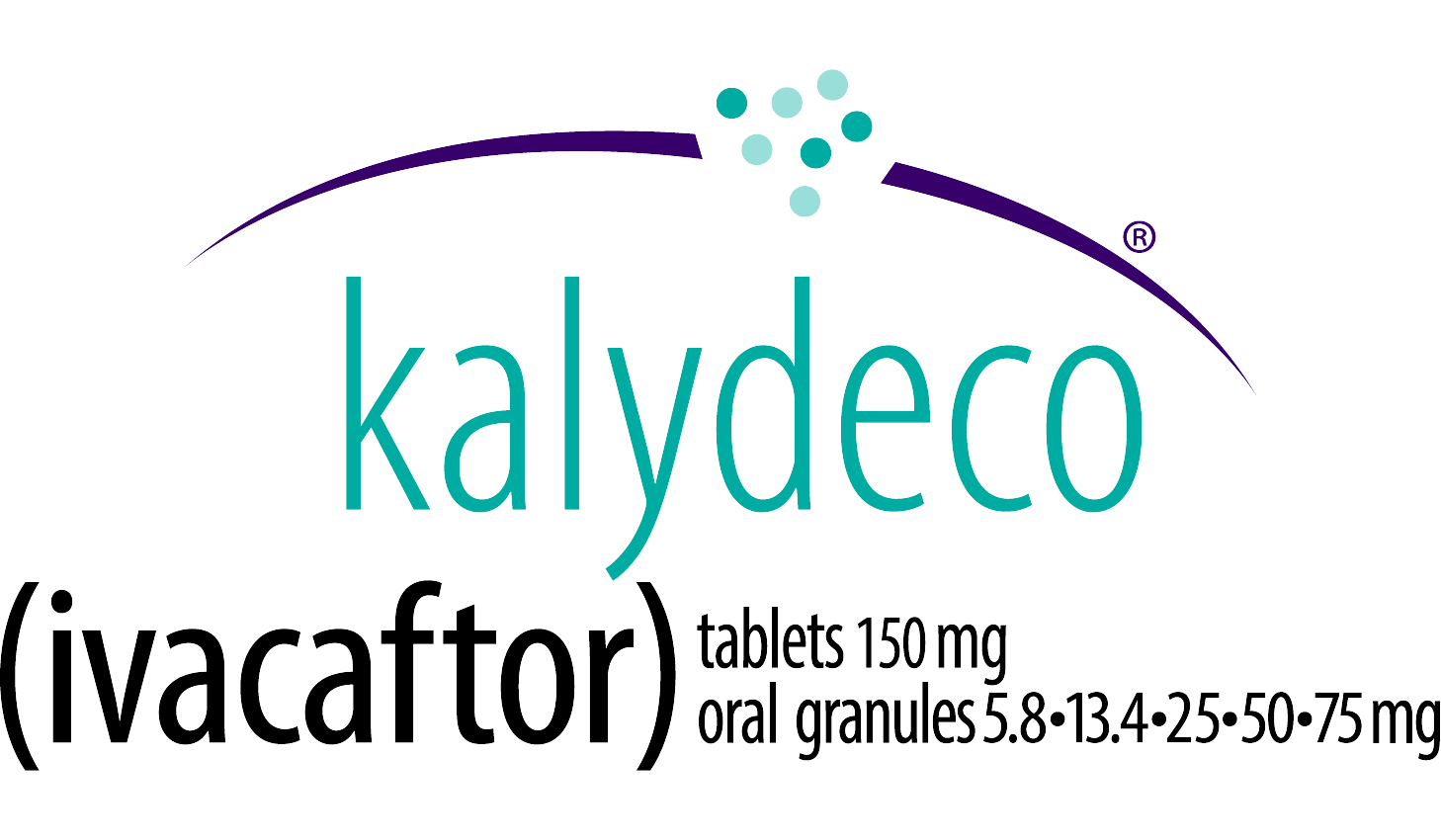Overall KALYDECO® (ivacaftor) safety profile established in clinical trials
The overall safety profile for KALYDECO® (ivacaftor) is based on Trials 1, 2, and 31
- The overall safety profile for KALYDECO is based on pooled data from 3 placebo-controlled clinical trials conducted in 353 patients age 6 years and older with CF who had a G551D mutation in the CFTR gene (Trials 1 and 2) or were homozygous for the F508del mutation (Trial 3)
- KALYDECO is not indicated in patients with CF who are homozygous for the F508del mutation
Pooled safety data from Trials 1, 2, and 31,a,b
- The proportion of patients who prematurely discontinued study drug due to adverse reactions (ARs) was 2% for patients treated with KALYDECO and 5% for patients treated with placebo
- Serious ARs that occurred more frequently in patients treated with KALYDECO included:
ABDOMINAL PAIN
INCREASED HEPATIC ENZYMES
HYPOGLYCEMIA
- The most common ARs in patients treated with KALYDECO in Trials 1, 2, and 3 (N=221) were headache (17%), upper respiratory tract infection (16%), nasal congestion (16%), nausea (10%), rash (10%), rhinitis (6%), dizziness (5%), arthralgia (5%), and bacteria in sputum (5%)1
Most common ARs in Trials 1 and 21
| MOST COMMON ARs (≥ 8%) IN PATIENTS WITH A G551D MUTATION TREATED WITH KALYDECO AND GREATER THAN PLACEBO1 | ||
|---|---|---|
|
ADVERSE REACTION |
KALYDECO |
PLACEBO |
| Headache | 26 (24) | 17 (16) |
| Oropharyngeal pain | 24 (22) | 19 (18) |
| Upper respiratory tract infection | 24 (22) | 14 (14) |
| Nasal congestion | 22 (20) | 16 (15) |
| Abdominal pain | 17 (16) | 13 (13) |
| Nasopharyngitis | 16 (15) | 12 (12) |
| Diarrhea | 14 (13) | 10 (10) |
| Rash | 14 (13) | 7 (7) |
| Nausea | 13 (12) | 11 (11) |
| Dizziness | 10 (9) | 1 (1) |
- The safety profile for the patients with CF enrolled in the other clinical trials (Trials 3-8) was similar to that observed in the 48-week placebo-controlled trials (Trials 1 and 2)1,c-g
Transaminase elevations in patients age 6 years and older1,a,b
- In Trials 1, 2, and 3, the incidence of maximum transaminase (ALT or AST) >8, >5, or >3 x ULN was 2%, 2%, and 6% in patients treated with KALYDECO and 2%, 2%, and 8% in patients treated with placebo, respectively
- The proportion of patients who permanently discontinued treatment for elevated transaminases, all >8 x ULN, was 0.5% for patients treated with KALYDECO and 2% for patients treated with placebo
- 2 patients treated with KALYDECO were reported to have serious ARs of elevated liver transaminases compared to none on placebo
- Transaminase elevations were more common in patients with a history of transaminase elevations
Transaminase elevations in patients age 1 month to <6 years1,e,g
- In Trial 6, the incidence of patients experiencing transaminase elevations (ALT or AST) >3 x ULN was 14.7% (5/34). All 5 patients had maximum ALT or AST levels >8 x ULN, which returned to baseline levels following interruption of KALYDECO dosing
- Transaminase elevations were more common in patients who had abnormal transaminases at baseline
- KALYDECO was permanently discontinued in 1 patient
- In Trial 8, 1 patient (14.3%) from the cohort of patients aged 1 to <4 months (n=7) had maximum ALT >8 x ULN and maximum AST of >3 to ≤5 x ULN; the subject discontinued ivacaftor treatment. In the cohort of patients aged 4 to <6 months, no patients experienced transaminase elevations; In the cohort of patients aged 6 to <12 months, 1 patient (9.1%) had elevated ALT of >3 to ≤5 x ULN. The incidence of patients experiencing ALT or AST >3, >5, and >8 x ULN in the cohort of patients aged 12 to <24 months was 27.8%, 11.1%, and 11.1%, respectively.
aTrials 1 and 2 were 48-week, Phase 3, randomized, double-blind, placebo-controlled trials in 213 patients with a G551D mutation. Trial 1 patients were 12 years of age and older; Trial 2 patients were age 6 to 11 years.1
bTrial 3 was a 16-week, randomized, double-blind, placebo-controlled, parallel-group trial in 140 patients with CF age 12 years and older who were homozygous for the F508del mutation. KALYDECO is not effective in patients with CF who are homozygous for the F508del mutation in the CFTR gene.1
cTrial 4 was an 8-week, crossover design trial in 39 patients with a G1244E, G1349D, G178R, G551S, G970R, S1251N, S1255P, S549N, or S549R mutation. Trial 4 patients were between the ages of 6 and 57 years.1
dTrial 5 was a 24-week, placebo-controlled trial in 69 patients with an R117H mutation. Trial 5 patients were between the ages of 6 and 68 years.1
eTrial 6 was a 24-week, open-label trial in 34 patients who could have had a G551D, G1244E, G1349D, G178R, G551S, G970R, S1251N, S1255P, S549N, or S549R mutation. Of the 34 patients enrolled, 32 had the G551D mutation and 2 had the S549N mutation. Trial 6 patients were 2 to <6 years of age.1
fTrial 7 was an 8-week crossover design trial involving patients between the ages of 12 and 72 years who were heterozygous for the F508del mutation and a second CFTR mutation predicted to be responsive to ivacaftor. A total of 156 patients were randomized to and received KALYDECO.1
gTrial 8 was a 24-week, open-label trial in a cohort of 19 patients age 12 months to <24 months, a cohort of 11 patients age 6 months to <12 months, and a cohort of 6 patients age 4 months to <6 months, and a cohort of 7 patients age 1 month to <4 months who could have a G551D, G1244E, G1349D, G178R, G551S, R117H (eligible for this study only in the US), S1251N, S1255P, S549N, or S549R mutation.1-4
IMPORTANT SAFETY INFORMATION
WARNINGS AND PRECAUTIONS
Transaminase (ALT or AST) Elevations
- Elevated transaminases have been reported in patients with CF receiving KALYDECO. Transaminase elevations were more common in patients with a history of transaminase elevations or in patients who had abnormal transaminases at baseline. ALT and AST should be assessed prior to initiating KALYDECO, every 3 months during the first year of treatment, and annually thereafter. For patients with a history of transaminase elevations, consider more frequent monitoring of liver function tests
- Patients who develop increased transaminase levels should be closely monitored until the abnormalities resolve. Dosing should be interrupted in patients with ALT or AST of greater than 5 times the upper limit of normal (ULN). Following resolution of transaminase elevations, consider the benefits and risks of resuming KALYDECO
INDICATIONS AND USAGE
KALYDECO is indicated for the treatment of cystic fibrosis (CF) in patients age 1 month and older who have at least one mutation in the CFTR gene that is responsive to ivacaftor potentiation based on clinical and/or in vitro assay data.
If the patient's genotype is unknown, an FDA-cleared CF mutation test should be used to detect the presence of a CFTR mutation followed by verification with bi-directional sequencing when recommended by the mutation test instructions for use.
INDICATIONS AND USAGE
KALYDECO is indicated for the treatment of cystic fibrosis (CF) in patients age 1 month and older who have at least one mutation in the CFTR gene that is responsive to ivacaftor potentiation based on clinical and/or in vitro assay data.
If the patient's genotype is unknown, an FDA-cleared CF mutation test should be used to detect the presence of a CFTR mutation followed by verification with bi-directional sequencing when recommended by the mutation test instructions for use.
IMPORTANT SAFETY INFORMATION
WARNINGS AND PRECAUTIONS
Transaminase (ALT or AST) Elevations
- Elevated transaminases have been reported in patients with CF receiving KALYDECO. Transaminase elevations were more common in patients with a history of transaminase elevations or in patients who had abnormal transaminases at baseline. ALT and AST should be assessed prior to initiating KALYDECO, every 3 months during the first year of treatment, and annually thereafter. For patients with a history of transaminase elevations, consider more frequent monitoring of liver function tests
- Patients who develop increased transaminase levels should be closely monitored until the abnormalities resolve. Dosing should be interrupted in patients with ALT or AST of greater than 5 times the upper limit of normal (ULN). Following resolution of transaminase elevations, consider the benefits and risks of resuming KALYDECO
Hypersensitivity Reactions, Including Anaphylaxis
- Hypersensitivity reactions, including cases of anaphylaxis, have been reported in the postmarketing setting. If signs or symptoms of serious hypersensitivity reactions develop during treatment, discontinue KALYDECO and institute appropriate therapy. Consider the benefits and risks for the individual patient to determine whether to resume treatment with KALYDECO
Concomitant Use With CYP3A Inducers
- Use of KALYDECO with strong CYP3A inducers, such as rifampin, substantially decreases the exposure of ivacaftor, which may reduce the therapeutic effectiveness of KALYDECO. Co-administration of KALYDECO with strong CYP3A inducers, such as rifampin, rifabutin, phenobarbital, carbamazepine, phenytoin, and St. John's wort is not recommended
Cataracts
- Cases of non-congenital lens opacities/cataracts have been reported in pediatric patients treated with KALYDECO. Baseline and follow-up ophthalmological examinations are recommended in pediatric patients initiating treatment with KALYDECO
ADVERSE REACTIONS
Serious Adverse Reactions
- Serious adverse reactions, whether considered drug-related or not by the investigators, which occurred more frequently in patients treated with KALYDECO included abdominal pain, increased hepatic enzymes, and hypoglycemia
Most Common Adverse Reactions
- The most common adverse reactions in the 221 patients treated with KALYDECO were headache (17%), upper respiratory tract infection (16%), nasal congestion (16%), nausea (10%), rash (10%), rhinitis (6%), dizziness (5%), arthralgia (5%), and bacteria in sputum (5%)
- The safety profile for the CF patients enrolled in clinical trials (Trials 3-8) was similar to that observed in the 48-week, placebo-controlled trials (Trials 1 and 2)
USE IN SPECIFIC POPULATIONS
Pediatric Use
- The safety and effectiveness of KALYDECO in patients with CF younger than 1 month of age have not been established. The use of KALYDECO in children under the age of 1 month is not recommended
- Use of KALYDECO in patients aged 1 to less than 6 months born at a gestational age less than 37 weeks has not been evaluated
Click here to access full Prescribing Information.
References:
1. KALYDECO [prescribing information]. Boston, MA: Vertex Pharmaceuticals Incorporated; August 2023. 2. Rosenfeld M, Wainwright CE, Higgins M, et al. Ivacaftor treatment of cystic fibrosis in children aged 12 to <24 months and with a CFTR gating mutation (ARRIVAL): a phase 3 single-arm study. Lancet Respir Med. 2018;6(7):545-553. 3. Rosenfeld M, Wainwright CE, Higgins M, et al. Ivacaftor treatment of cystic fibrosis in children aged 12 to <24 months and with a CFTR gating mutation (ARRIVAL): a phase 3 single-arm study. Lancet Respir Med. 2018;6(7)(suppl):545-553. 4. Davies JC, Wang LT, Campbell D, et al. Ivacaftor treatment in patients 6 to <12 months old with a CFTR gating mutation: results of a Phase 3, two-part, single-arm study. Poster and abstract presented at: North American Cystic Fibrosis Conference; October 2018; Denver, CO.

